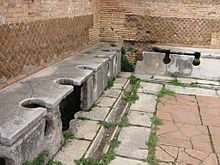


1) Bench
2) Main water channel
3) Front water channel
4) Wall
5) Window
6) Divider
7) Washbasin
A latrine is a toilet or an even simpler facility that is used as a toilet within a sanitation system. For example, it can be a communal trench in the earth in a camp to be used as emergency sanitation, a hole in the ground (pit latrine), or more advanced designs, including pour-flush systems.
The term "latrine" is still commonly used military parlance,[1] less so in civilian usage except in emergency sanitation situations.[2] Nowadays, the word "toilet" is more commonly used than "latrine", except for simple systems like "pit latrine" or "trench latrine".[citation needed]
The use of latrines was a major advancement in sanitation over more basic practices such as open defecation, and helped control the spread of many waterborne diseases. However, unsafe defecation in unimproved latrines still remained a widespread problem by the end of 2020, with more than 3 billion people affected (46 % of the global population). Eradication of this public health threat is one of the United Nations' 17 goals for sustainable development.[3]
- ^ "Field Facilities for Human Waste Disposal". Army Study Guide. Archived from the original on 24 May 2021. Retrieved 24 May 2021.
- ^ Peter Harvey; et al. (2007). Excreta disposal in emergencies a field manual : an inter-agency publication. Loughborough: Loughborough university. Water, engineering and development centre (WEDC). p. 250. ISBN 9781843801139. Archived from the original on 2017-10-11. Retrieved 2018-03-28.
- ^ Okram, Julion (2021). "Inadequate sanitation: Monitoring and prospective eradication by 2030". Archived from the original on 26 August 2021. Retrieved 26 August 2021.